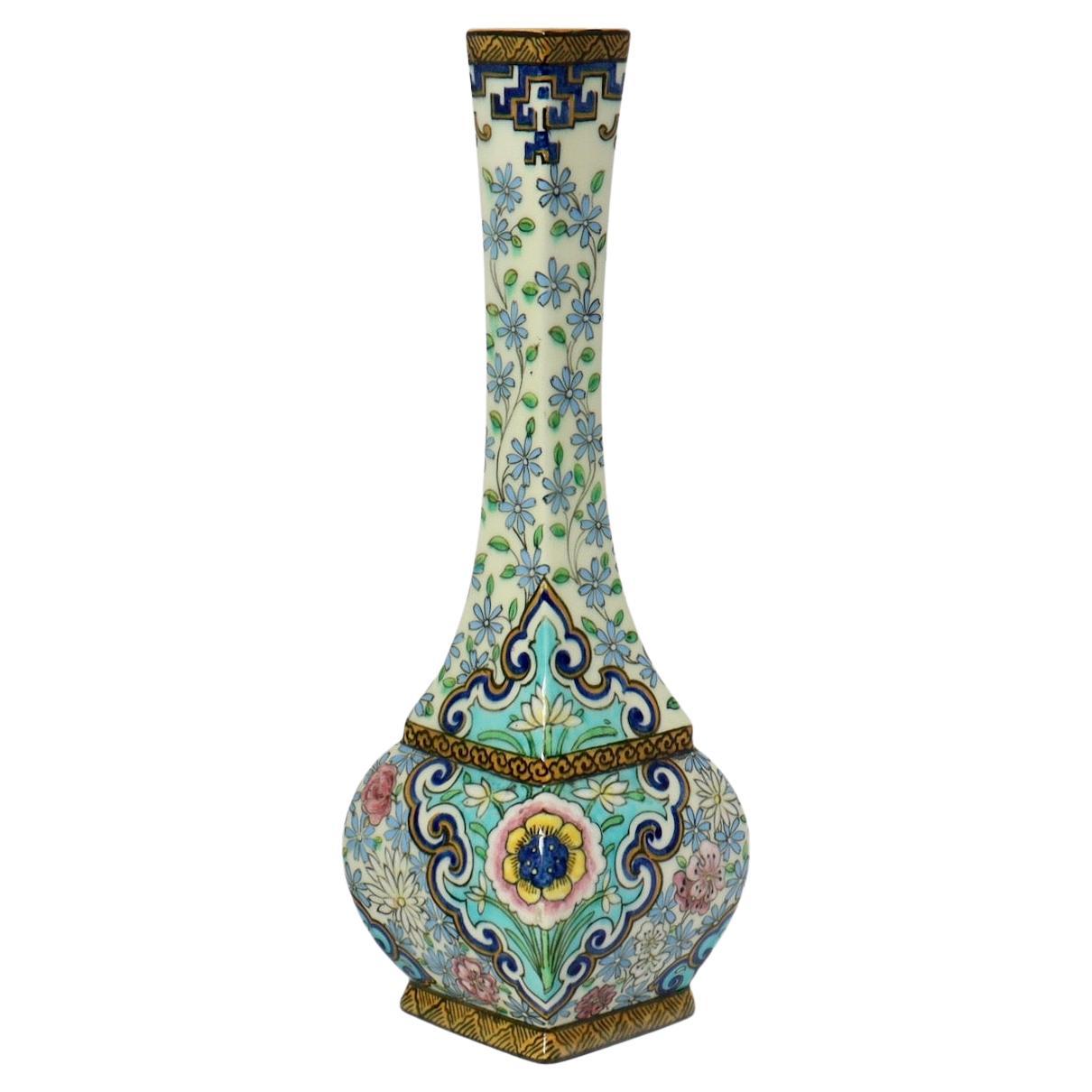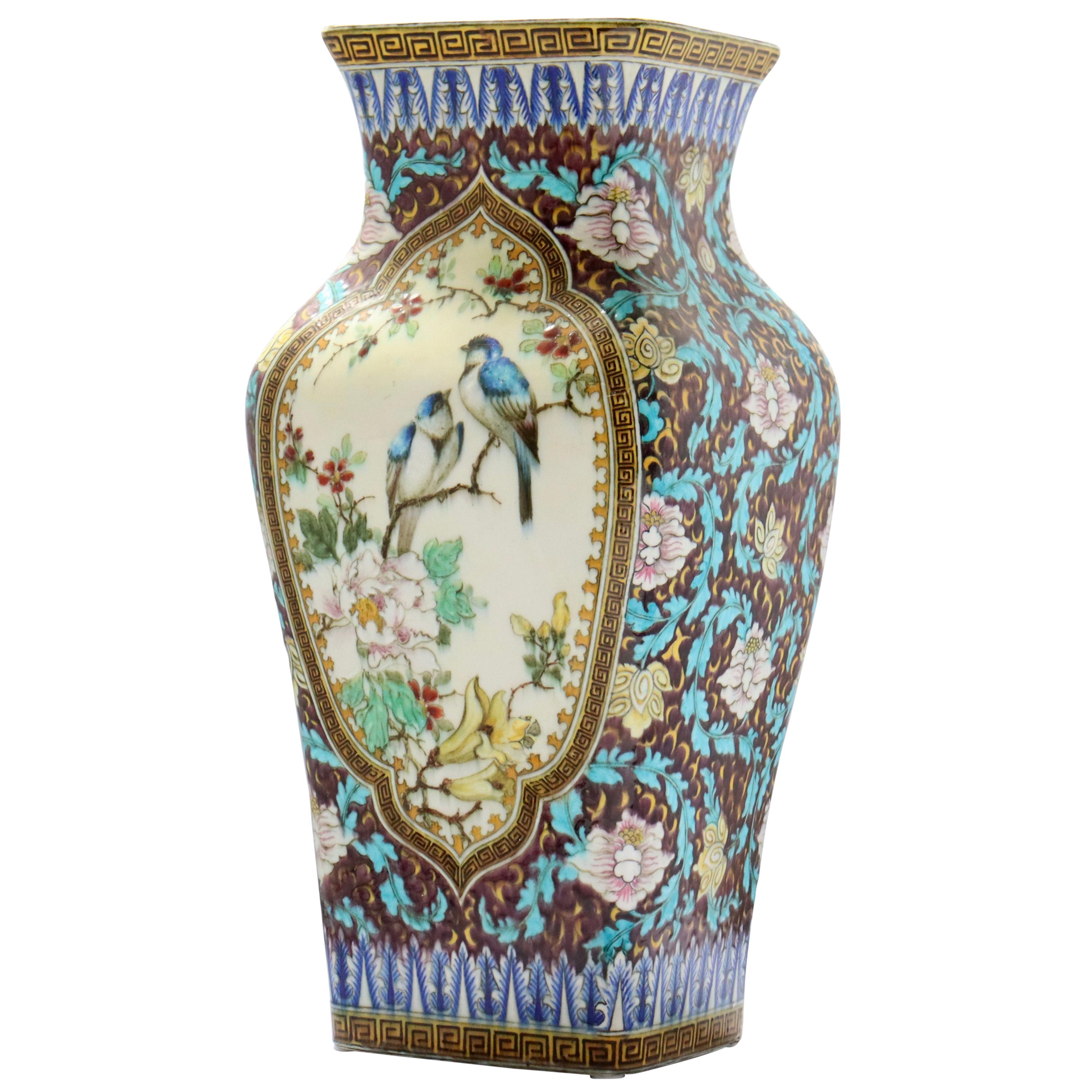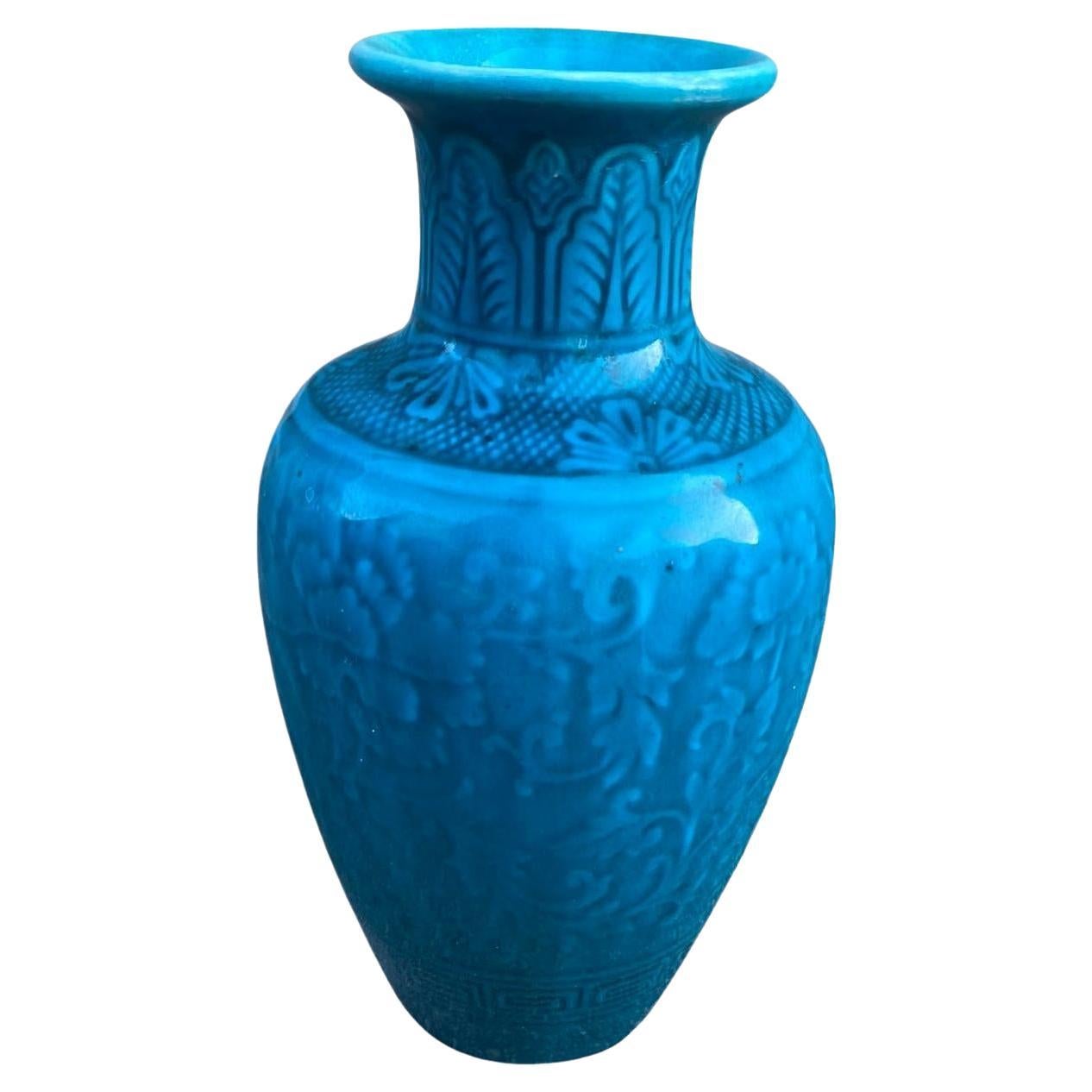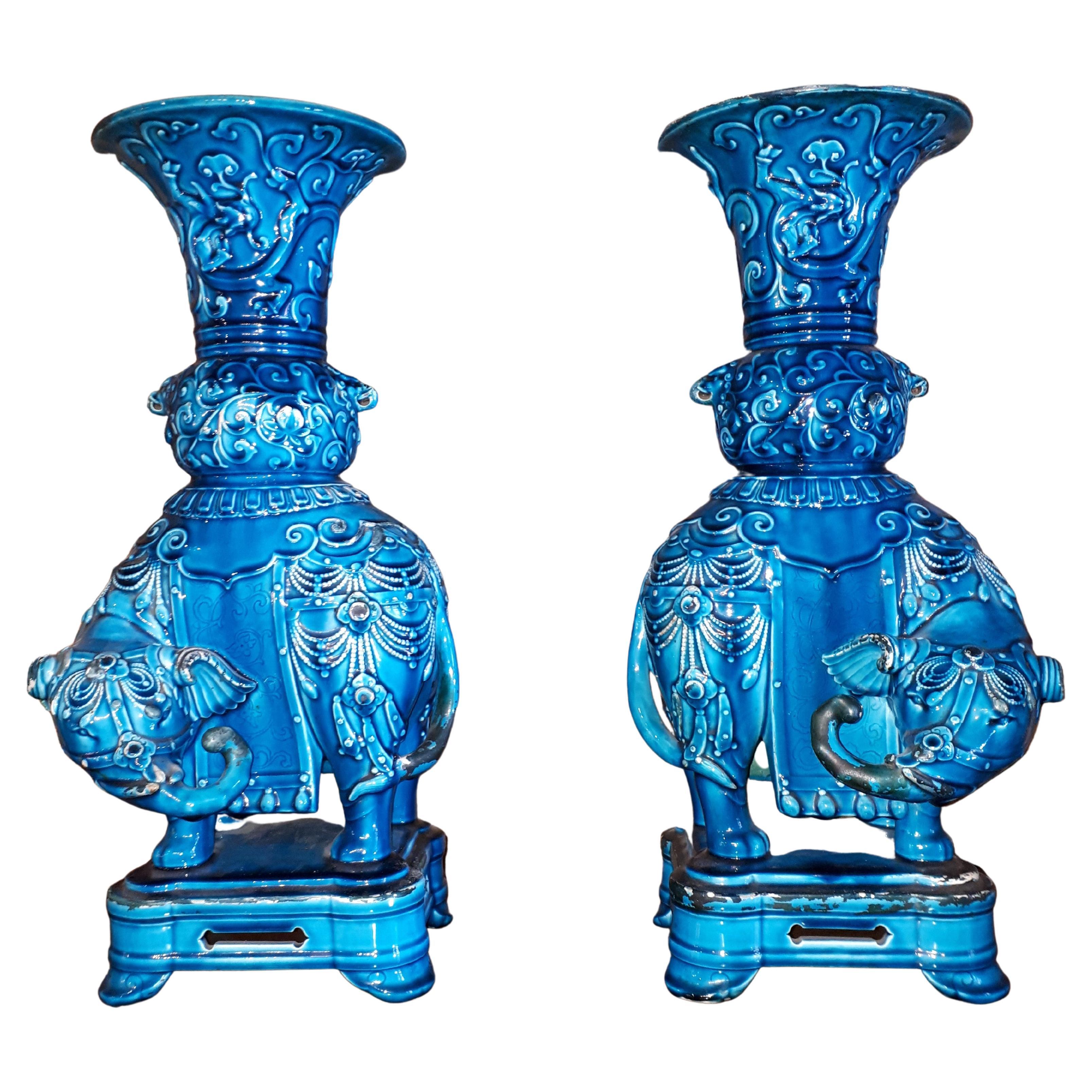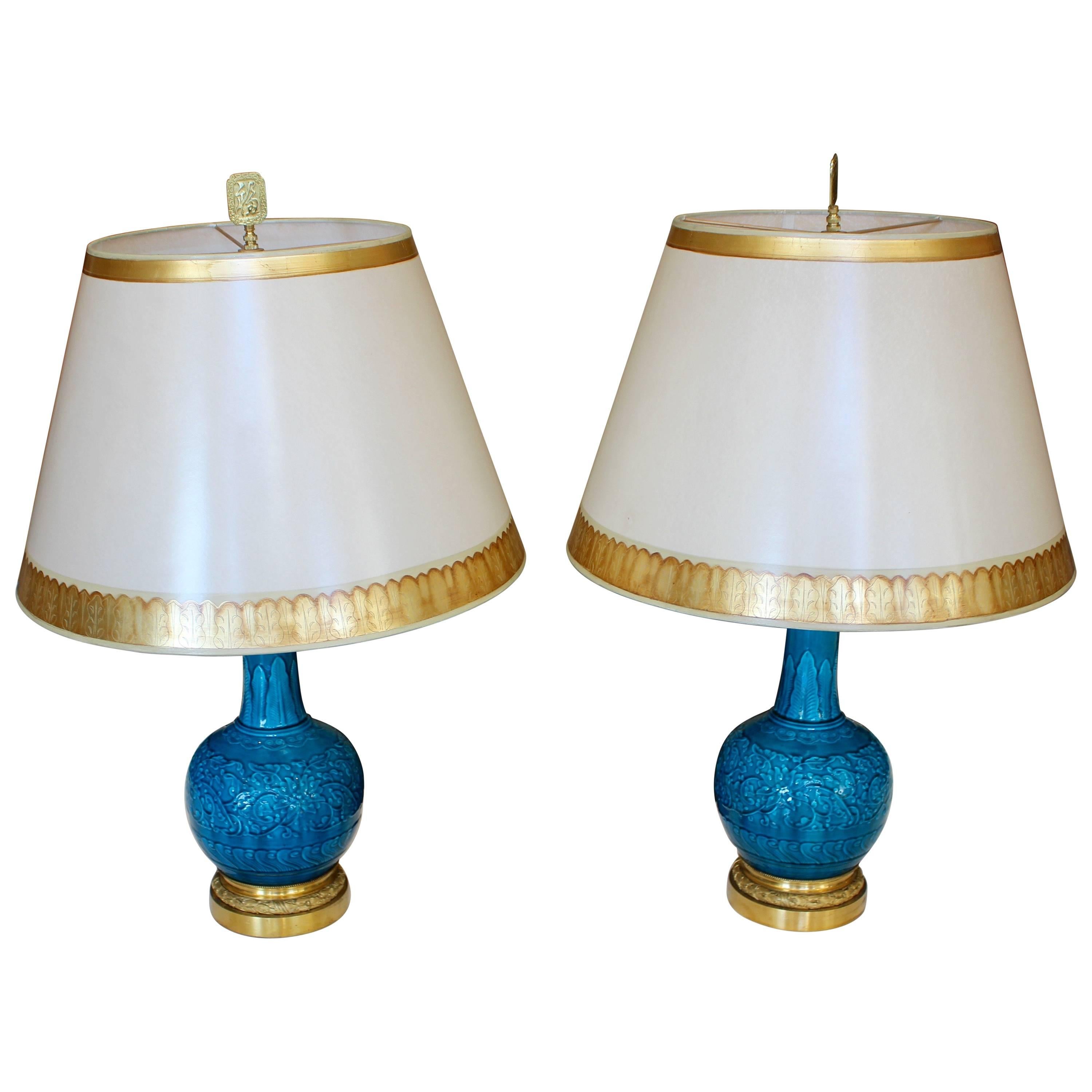Items Similar to Théodore Deck (1823-1891), Miniature Pair of Faience Vases circa 1870
Want more images or videos?
Request additional images or videos from the seller
1 of 9
Théodore Deck (1823-1891), Miniature Pair of Faience Vases circa 1870
About the Item
Theodore Deck (1823-1891)
A deep green enameled faience miniature pair of vases molded in the Chinese Archaistic Taste.
Coves in the shape of elephant heads.
With open-worked ormolu mounts to the base and the rim
Uppercased TH.D impressed mark.under the base
Bibliography : "Théodore Deck ou l'éclat des émaux 1823 - 1891", Musées de Marseille
Similar model illustrated page 68 under number 48.
Renowned ceramist, Théodore Deck, born in Guebwiller in 1823, apprenticed in Strasbourg in the Hügelin pottery. After an initiatory stay throughout Europe, he arrived in Paris in 1847. It was in 1861 that he made his first public appearance at the Salon des Arts et de l'Industrie in Paris, where he won a silver medal for his exhibited works. Recognized since that time, Deck is deeply influenced by the artistic trend of the moment: Orientalism. He then uses with great precision the Oriental naturalistic motifs. Emile Reiber (1826-1893), who worked at Christofle as chief draughtsman, also made sketches for Deck. His fame won by long works is imposed at the Universal Exhibitions in which he participates: in Vienna in 1873, where he leaves all his rivals behind; in Paris in 1878, where he obtains the grand prize for portraits with a gold background. The "Gazette des Beaux-Arts" (Paris, 1874, Vol. XXXV, p. 310) reported that "Mr Deck, the master of the masters, is the purest glory of French ceramics." His life is a succession of achievements whose goal is to improve the technology of earthenware. Thus it improves the rendering of colors, among which is a novelty, a turquoise blue commonly called «Deck Blue». Theodore Deck is talented and knows it. However he does not keep his art to himself, he shares it with other artists and launches young talents without fortune. It illustrates the revival of ceramic art in the second half of the 19th century. All his methods are made public and disseminated in a book on earthenware. His recognized genius, promoted to the rank of Officer of the Legion of Honor, he was appointed in 1887 administrator of the manufacture of Sèvres.
- Creator:Theodore Deck (Maker)
- Dimensions:Height: 4.34 in (11 cm)Width: 2.96 in (7.5 cm)Depth: 2.37 in (6 cm)
- Sold As:Set of 2
- Style:Chinoiserie (Of the Period)
- Materials and Techniques:Faience,Enameled
- Place of Origin:
- Period:
- Date of Manufacture:circa 1870
- Condition:Wear consistent with age and use.
- Seller Location:Saint-Ouen, FR
- Reference Number:1stDibs: LU2612338636052
About the Seller
4.9
Vetted Seller
These experienced sellers undergo a comprehensive evaluation by our team of in-house experts.
1stDibs seller since 2017
56 sales on 1stDibs
Typical response time: 1 hour
- ShippingRetrieving quote...Ships From: Saint-Ouen, France
- Return PolicyThis item cannot be returned.
More From This SellerView All
- A Théodore Deck (1823-1891) Enamelled Faience Soliflore Vase circa 1875By Theodore DeckLocated in Saint-Ouen, FRThéodore DECK (1823-1891) A polychromatic enamelled earthenware soliflore and quadrangular shape vase with Sino-Japanese inspiration design of flowers and geometrical friezes all around. Impressed uppercase mark "TH.DECK" under the base. Circa 1875 Born in Guebwiller in Alsace, Théodore Deck trained as a ceramist in his home region, then in Germany. He went into partnership with his brother, Xavier Deck, to create his own factory in Paris in 1858. At the Exhibition of Industrial Arts in 1864, he presented pieces covered with transparent enamels that were not cracked, and then made his first attempts at reliefs under transparent enamels. He developed a bright turquoise color, famously renowned as "Bleu Deck". It is this nuance that we find on the salamander represented on this vase. In 1887 he published a treatise entitled "La Faïence", in which he explained some of his discoveries. That same year, he became director of the Manufacture de Sèvres. Theodore Deck (1823-1891) is a French ceramist born in Guebwiller in Alsace. He is passionate about chemistry and the physical sciences. In 1841, he joined the master stove maker Hügelin father as an apprentice in Strasbourg. In two years, he learned of the methods inherited from the 16th century, such as the encrustation of colored pastes in the style of Saint-Porchaire. This apprenticeship did not prevent him from spending his free time draw-ing or modeling clay in the studio of sculptor André Friederich. Escaping military service, he made a tour of Germany as is the tradition with fellow Alsatian stove-makers. The quality of his work allows him to obtain important orders in Austria for the castles of the provinces and the imperial palaces, in particular for the palace of Schönbrunn. He continues his journey in Hungary to Pest, to Prague, then, going north through Dresden, Leipzig, Berlin and Hamburg. On the strength of his apprenticeship, he arrived in Paris in 1847. Recommended by Hügelin, he went to the stove factory of the Bavarian potter Vogt, located rue de la Roquette. The Revolution of 1848 interrupts production and Deck decides to return to his hometown. His family then advised him to set up a small terracotta workshop: he made a few busts, statuettes, vases, lamps and copies of famous antiques there. Aware that this situation would not allow him to provide for himself properly, he returned to Paris in 1851 where he was employed by the widow Dumas, daughter of the earthenware maker Vogt for whom he had worked. Hired as a foreman, he supplied the drawings and models to the workers, while working the land himself. The following year, he made the decision to settle not far from his former employer at 20, rue de la Fontaine-au-Roi, probably using his ovens. His brother, Xavier Deck, joins him. It was officially in 1858 that the Deck brothers created their business and settled in Paris at 46, boulevard Saint-Jacques. Initially, the brothers only carry out coatings for stoves. But the business is going so well that barely a year after their installation, they want to diversify their production and engage in ceramics for the cladding of buildings as well as in shaped parts. Deck is interested in politics. In 1870, he opted for French nationality and was elect-ed deputy mayor in the 15th arrondissement of Paris. In 1861, at the Salon des arts et industries de Paris, which was held on the Champs-Élysées, Théodore Deck exhibited his works for the first time: these were pieces with an inlay decoration called “Henri II” and others. pieces covered with turquoise blue enamel or decoration in the style of Iznik ceramics.If he wins a silver medal, reviews are mixed, however. The following year, on the occasion of the Universal Exhibition of 1862 in London, he won over English customers. He surprised by presenting, like the previous year, his Alhambra Vase...Category
Antique 1870s French Japonisme Vases
MaterialsFaience
- Theodore Deck '1823-1891', a Japonisme Polychromed Faience Quadrangular VaseBy Theodore DeckLocated in Saint-Ouen, FRTheodore Deck (1823-1891) A Polychromed Faience quadrangular vase, decorated in a cartouche with butterfly and birds on branches of prunus and peonies in the Japanese Taste on a pu...Category
Antique Late 19th Century French Japonisme Vases
MaterialsFaience
- Théodore Deck (1823-1891) Faience Paneled Fourteen-Tile Rectangular Wall PlaquBy Theodore DeckLocated in Saint-Ouen, FRA Théodore Deck (1823-1891) Faience Paneled Fourteen-Tile Rectangular Wall Plaque Polychromic Earthenware very finely hand-painted, designed with a couple of pheasants among vegetat...Category
Antique 1870s French Japonisme Decorative Art
MaterialsFaience, Wood
- French 19th Century Pair of Lacquered Bamboos Japonisme VasesBy Edouard Lievre, Ferdinand BarbedienneLocated in Saint-Ouen, FRA 19th French century pair of Lacquered Bamboos Japonisme vases. An amazing pair of tall cylindrical bamboo vases decorated in Japanese Gold and Sil-ver Hiramaki-E Lacquer with Pavilions in The Mist and Weaving Figures, Flown Over by a Pair of Cranes. Enclosed in a Sino-Japanese Inspiration Golden and Brown Patina Bronze Mount Featuring Elephant Heads, Partially Openwork Branches and Salamanders Forming Side Handles. Circa 1870 Attributed to Édouard Lièvre (1828-1886) and Ferdinand Barbedienne (1810-1892) Édouard Lièvre (1828-1886) is one of the most talented and prolific designer and industrialist of the 19th Century, his repertoire is sometimes Sino-Japanese or Neo-Renaissance, whether in furniture or works of art, we can note in particular the parade bed of Valtesse de La Bigne, furniture commissioned by the painter Édouard Detaille or even Sarah Bernhardt, and the famous works in collaboration with Maison Christofle or those in gilded bronze and cloisonné enamel edited by Ferdinand Barbedienne, presented at the Universal Exhibitions in 1878, 1889 and 1900. He was both a draftsman, painter, illustrator, engraver, ornamentalist and cabinetmaker, first trained in the studio of the painter Thomas Couture, Lièvre was then fully immersed in the world of decoration, creation and ornamentation and provides designs for manufacturers and merchant-publishers. Often assisted by his brother Justin, he first produced works of art for his own apartment, seeking out the finest craftsmen to execute his designs for bronzes, ceramics, fabrics and luxury furniture from great virtuosity and great taste. He then collaborated with the cabinet-maker Paul Sormani, as well as haberdasher merchants such as the Escalier de Cristal, bronziers such as Maison Marnyhac and especially Ferdinand Barbedienne as on our vases with bronze mounts characteristics of Edouard Lièvre's work. Born in 1810, died in Paris in 1892, Ferdinand Barbedienne, the most important caster of bronze pieces of art during the second half of the 19th Century, created and directed in Par-is one of the major artistic foundries of his time. Barbedienne specialized in classical reproductions, whose models were exposed in famous European museums. Their illustrated catalogues included many diverse objects such as busts, ornemental sculpture (clocks, candelabras, cups) sometimes even life-sized and bronzes for furniture. Apart from his own produc-tion, Barbedienne worked for the most renowned sculptors such as Barrias, Clésinger and Carrier-Belleuse. All his works were highly esteemed and he, himself honored by contemporary critics. At the London exhibition in 1851 Barbedienne’s firm won two « Council medals ». At the 1855 Universal Exhibition, he won a medal of honor. The success of Barbedienne’s firm brought him many official commissions, such in about 1860, as Barbedienne supplied bronzes for furniture for the Pompeian Villa of Prince Napoléon-Joseph, located avenue Montaigne in Paris. At the London Universal Exhibition of 1862 Barbedienne won medals in three different categories: Furniture, Silversmith work and Artistic bronzes. Barbedienne was made an officer of the Légion d’Honneur in 1867 and Commander in 1878 when he was compared with « a prince of industry and the king of bronze casting ». His glory did not decline with the passage of the time for at the Universal Exhibition of 1889 the critics thanked Barbedienne for the example he set for other bronze-casters by the perfection of his bronzes. “Japonisme” in the second half of the 19th century, was a craze for everything that came from Japan or imitated its style. The word was first coined in a series of articles published by Philippe Burty, from May 1872 to February 1873, in the French magazine “la Renaissance Littéraire et Artistique”. Far from the Academic sphere, artists seeking for new ways of expression, appropriated this discovery. Manet and the impressionists led the way to half a century of enthusiasm for Japanese art, and largely contributed to the esthetical revolution Europe experienced between 1860 and the beginning of the twentieth century. From 1862, The World’s Fairs provoked massive arrivals of fans, kimonos, lacquers, bronzes, silks, prints and books that launched the real era of Japonisme. With those exhibitions, the demand was boosted, the number of merchants and collectors was multiplied, and artists became passionate about this new esthetic. For them, its “primitivism” was probably its most important quality: artists were fond of the Japanese art’s capacity to be close to nature and to reconcile art and society by representing, with a lot of care, the most trivial objects. In painting, Edouard Manet, Mary Cassatt, Degas, Van Gogh, Gauguin were among those who were deeply inspired by Japanese art, affected by the lack of perspective and shadow, the flat areas of strong color, the compositional freedom in placing the subject off-center, with mostly low diagonal axes to the background. The Japanese iris, peonies, bamboos, kimonos, calligraphy, fish, butterflies and other insects, the blackbirds, cranes and wading birds, the cats, tigers, and dragons were endless sources of inspiration, appropriation, and reinterpretation for European artists. The occidental productions were combining styles and artistic conceptions instead of copying Japanese art slavishly. That is what brings to light the comparison between the artworks of Kitagawa Utamaro and Degas, of Katsushika Hokusai and Van Gogh The World’s Fairs of 1851 and 1862 in London, those of 1867, 1878, 1889 and 1900 in Paris, of 1873 in Vienna and of 1904 in Saint Louis presented a number of “Japanese-Chinese” installations with earthenware, bronzes, screens and paintings and attracted the largest amounts of visitors In Vienna, the “Japanese village...Category
Antique 1870s French Japonisme Vases
MaterialsBronze
- French 19th Century Pair of Porcelain Cache-PotsLocated in Saint-Ouen, FRPair of polychromed hand painted porcelain with Japonisme floral decoration Ormolu-mounted with open-worked base and rim Louis XVI Style circa 1880.Category
Antique 1870s French Chinoiserie Planters, Cachepots and Jardinières
MaterialsOrmolu
- A Daum Art Deco Acid-Etched Glass Vase, circa 1930By DaumLocated in Saint-Ouen, FR"Parrots" A Daum Nançy France Art Deco Acid-etched Glass Vase, circa 1930 Large Cameo and overlaid glass vase, decorated with parrots. Etched to foot rim DAUM NANCY FRANCE with Cross...Category
Vintage 1920s French Art Deco Glass
MaterialsArt Glass
You May Also Like
- Théodore Deck, Ceramic Vase, Signed, circa 1870By Theodore DeckLocated in Saint-Ouen, FRThéodore Deck (1823-1891), ceramic vase, signed, circa 1870.Category
Antique Late 19th Century French Art Nouveau Ceramics
MaterialsCeramic
- Pair of Theodore Deck VasesBy Theodore DeckLocated in Saverne, Grand EstExtremely rare pair of Gu-shaped turquoise enamelled ceramic vases, carried by elephants and resting on an openwork base ending in four flared feet. Some lack of enamel otherwise ver...Category
Antique 1880s French Japonisme Vases
MaterialsCeramic
- Pair of Ormolu-Mounted Theodore Deck Faience Persian-Blue Vases with LampshadesBy Theodore DeckLocated in Palm Desert, CAA pair of late 19th century ormolu-mounted faience Persian-blue vases by Theodore Deck, mounted as oil lamps. As in traditional Persian design, the lamps are bottle-shaped, with a wi...Category
Antique 19th Century French Vases
MaterialsOrmolu
- Pair of Gilt Bronze Mounted Faience Lamps by DeckBy Gagneau Frères, Theodore DeckLocated in London, GBThese beautiful table lamps are by Théodore deck, one of the most important ceramicists of the 19th Century, and Gagneau Frères, a leading bronzier. Deck was the director of a presti...Category
Antique Late 19th Century French Vases
MaterialsOrmolu, Bronze
- Large Theodore Deck Earthenware Bottle Form Vase in the Islamic/Iznik TasteBy Theodore DeckLocated in New York, NYA large and impressive Theodore Deck Earthenware bottle form vase in the Islamic/Iznik Taste, Impressed "TD" 1870 on the bottom. The narrow circular neck is decorated with dark blue,...Category
Antique 1870s French Islamic Vases
MaterialsPorcelain
- French Faience Cockatoo Double Vase, circa 1870By Hautin, Boulenger et Cie 1Located in New York, NYChoisy-Le-Roi Hautim Boulanger and Cie. Probably by Paul Comolera (French 1818-1897). The bird modelled with wings outstretched, perched between two open bamboo stems, black print...Category
Antique Late 19th Century French Vases
MaterialsFaience
Recently Viewed
View AllMore Ways To Browse
Pair Of Chinese Miniature Vases
Sevres Chinoiserie
Signoretto Murano
Tall Bamboo Vase
Bavarian Porcelain Vases
Yellow Opaline Vases
Il Coccio
Morning Glory Vase
Gourd Mold
Erik Skawonius
Hermanova Hut
Cobalt Bavaria
Retro Cloisonne Ornaments
Medici Crystal Vase
Ercole Barovier Crepuscolo Glass Vase
Jean Gerbino Mosaic Vase
Olsen Royal Copenhagen Crackle Glaze
Per Lutken Drop
